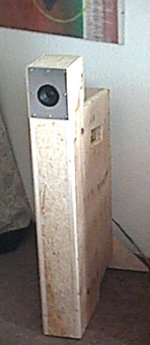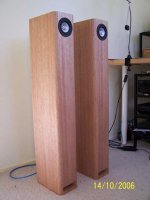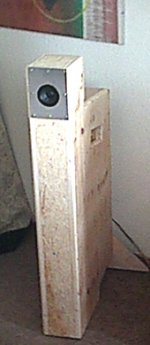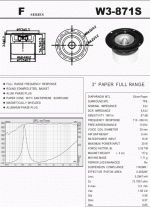FRS8M
did anyone tried the new FRS8M,
better Qts, 87 dB, in the Needle
my alternative is the TROMBONE
http://www.hm-moreart.de/106.htm
better soundstage more bass and max. SPL
did anyone tried the new FRS8M,
better Qts, 87 dB, in the Needle
my alternative is the TROMBONE
http://www.hm-moreart.de/106.htm
better soundstage more bass and max. SPL
Attachments
lohk
look here:
new horn for two 3" driver
http://www.diyaudio.com/forums/showthread.php?s=&threadid=80688
Nothfilter included
look here:
new horn for two 3" driver
http://www.diyaudio.com/forums/showthread.php?s=&threadid=80688
Nothfilter included
Needles FTW
The other day, I heard a pair of the Needles with Tang-Band drivers in them, built by a friendly and courteous fellow DIYer here in Iceland. They sound wonderful! Granted, I'm hifi-naive, but these were very convincingly one of the best sounding systems I've heard. Cat Power played beautifully out of the Needles and the Antique Sound Lab AV-8 tube monoblocks.
I guess the greatest surprise was that the 8W amps were enough, after reading that they Needles weren't that suited to low-power amps. I'd sort of imagined that more power would be necessary. Of course, up to the point of distortion the volume was hardly ear-shattering, but there was enough of it by any standards of mine.
The sound was indeed warm, as I've seen it described, and it had a reassuring heft and lovely punch on the drums. Klang+Ton thought these speakers were fascinating, and I believe that I agree, based on their sound, the looks, and the price.
The best educational experiences are those that naturally cause an irresistible curiosity-urge to dive in, learn more and do, and that then bear fruit that you'll enjoy for a long while afterwards, sitting around with good people and cups of tea. A thank-you to Herr Cyburgs for designing these and sharing them, and my sincere show of appreciation for the employed design philosophies. A great introduction to this deep and satisfying hobby, a great way to spend your time.
Edit: and of course, thanks to all the builders and the experimenters for their feedback and parcticipation, the sharing of knowledge and expertise.
The other day, I heard a pair of the Needles with Tang-Band drivers in them, built by a friendly and courteous fellow DIYer here in Iceland. They sound wonderful! Granted, I'm hifi-naive, but these were very convincingly one of the best sounding systems I've heard. Cat Power played beautifully out of the Needles and the Antique Sound Lab AV-8 tube monoblocks.
I guess the greatest surprise was that the 8W amps were enough, after reading that they Needles weren't that suited to low-power amps. I'd sort of imagined that more power would be necessary. Of course, up to the point of distortion the volume was hardly ear-shattering, but there was enough of it by any standards of mine.
The sound was indeed warm, as I've seen it described, and it had a reassuring heft and lovely punch on the drums. Klang+Ton thought these speakers were fascinating, and I believe that I agree, based on their sound, the looks, and the price.
The best educational experiences are those that naturally cause an irresistible curiosity-urge to dive in, learn more and do, and that then bear fruit that you'll enjoy for a long while afterwards, sitting around with good people and cups of tea. A thank-you to Herr Cyburgs for designing these and sharing them, and my sincere show of appreciation for the employed design philosophies. A great introduction to this deep and satisfying hobby, a great way to spend your time.
Edit: and of course, thanks to all the builders and the experimenters for their feedback and parcticipation, the sharing of knowledge and expertise.
Would it be a worthwhile experiment to load the driver of the needle on one of the sides, with the driver the same distance from the top but centered between the former front baffle and the top of the angled center baffle? the port would remain in the same place and now be side-firing. I've seen speaker designs kind of like this, I guess in order to have a larger front baffle. Ummm, thoughts? I guess you lose some of the slender/sleek aesthetic appeal, but maybe not?
erv
erv
Hi,
it could be interesting if one of you built my TABAQ and compared it to the Needle. It is very easy to put together, as I have made it as simple as possible.
One thing is doing simulations - another thing is how it works in real life.
I have not measured TABAQ, just used my ears with test tones and different types of music. I am very pleased with the result (of course, I made it myself. It is like a woman being a mother for the first time - her baby is the most beautiful baby in the entire world).
Please take a look at
http://coolcat.dk/bjoern/TABAQ_TL_for_TB.pdf
Hi from Bjorn
it could be interesting if one of you built my TABAQ and compared it to the Needle. It is very easy to put together, as I have made it as simple as possible.
One thing is doing simulations - another thing is how it works in real life.
I have not measured TABAQ, just used my ears with test tones and different types of music. I am very pleased with the result (of course, I made it myself. It is like a woman being a mother for the first time - her baby is the most beautiful baby in the entire world).
Please take a look at
http://coolcat.dk/bjoern/TABAQ_TL_for_TB.pdf
Hi from Bjorn
Very nice!
I sure going to build an pair of those.
Just wonder if its possible to use any other Tangband speaker?
Already have one pair 871 in an box.
Have some credits in http://www.hifidistribution.com/
that i want to use.
I sure going to build an pair of those.
Just wonder if its possible to use any other Tangband speaker?
Already have one pair 871 in an box.
Have some credits in http://www.hifidistribution.com/
that i want to use.
A question about the Needles:
I'm building an 41hz Amp6 for eventual use with Needles (and probably TABAQs as well ...). This is a Tripath amplifier, and it requires use of input capacitors, creating an RC filter on the input.
In its stock configuration, the filter has a corner frequency of 2.2 Hz. As the Needles and TABAQs have a useful frequency response starting from around 50Hz, I understand that the filter frequency could be raised a bit. This could enable use of "fancier" capacitors. Also a benefit of a smaller coupling cap in these amps is that turn-on thumps are lessened.
A possible benefit, if I understand correctly, is that frequencies below the speakers' frequency response range are attenuated. If I were to raise the filter's corner frequency to somewhere around 5-8Hz, the amp's output at 50hz should be free of phase distortion, while lessening output to the spekakers in the range below 50hz. My question is really whether it would be beneficial. What do speaker cones do when asked to reproduce signals below their frequency range? For example, what happens when a 20hz signal is fed to a Needle? Does the speaker just 'ignore' it, or does it have a detrimental effect on the rest of the frequency spectrum to ask the speaker to reproduce this 'impossible' signal?
Also, how close to the 50hz mark could the filter's rejection range be put? From the frequency graphs, there is *some* output below 50hz. A thought experiment: what if there was a "brickwall" filter that removed EVERYTHING below 50hz going to the speaker? Would there be an audible loss of anything, or would it just serve to clean up the signal, allowing the speaker to do its job better?
I hope I'm making myself clear The question, in its simplest form: would aiming the filter's response at an unspoiled frequency response above 50hz be useful? Should I go lower, and aim for clean output at ~40Hz and up?
The question, in its simplest form: would aiming the filter's response at an unspoiled frequency response above 50hz be useful? Should I go lower, and aim for clean output at ~40Hz and up?
Regarding the TABAQ speakers, I'm very interested. I'm planning to build both Needle and TABAQ boxes, and try 871 cones in them. I'm not sure how to read SPL/frequency graphs, but it seems that the TABAQ has a flatter response, but is quieter. I'd actually say that the TABAQ design warrants its own thread here on diyaudio, for easier reference and to help the discussion from getting tangled up with Needle issues.
I'm building an 41hz Amp6 for eventual use with Needles (and probably TABAQs as well ...). This is a Tripath amplifier, and it requires use of input capacitors, creating an RC filter on the input.
In its stock configuration, the filter has a corner frequency of 2.2 Hz. As the Needles and TABAQs have a useful frequency response starting from around 50Hz, I understand that the filter frequency could be raised a bit. This could enable use of "fancier" capacitors. Also a benefit of a smaller coupling cap in these amps is that turn-on thumps are lessened.
A possible benefit, if I understand correctly, is that frequencies below the speakers' frequency response range are attenuated. If I were to raise the filter's corner frequency to somewhere around 5-8Hz, the amp's output at 50hz should be free of phase distortion, while lessening output to the spekakers in the range below 50hz. My question is really whether it would be beneficial. What do speaker cones do when asked to reproduce signals below their frequency range? For example, what happens when a 20hz signal is fed to a Needle? Does the speaker just 'ignore' it, or does it have a detrimental effect on the rest of the frequency spectrum to ask the speaker to reproduce this 'impossible' signal?
Also, how close to the 50hz mark could the filter's rejection range be put? From the frequency graphs, there is *some* output below 50hz. A thought experiment: what if there was a "brickwall" filter that removed EVERYTHING below 50hz going to the speaker? Would there be an audible loss of anything, or would it just serve to clean up the signal, allowing the speaker to do its job better?
I hope I'm making myself clear
Regarding the TABAQ speakers, I'm very interested. I'm planning to build both Needle and TABAQ boxes, and try 871 cones in them. I'm not sure how to read SPL/frequency graphs, but it seems that the TABAQ has a flatter response, but is quieter. I'd actually say that the TABAQ design warrants its own thread here on diyaudio, for easier reference and to help the discussion from getting tangled up with Needle issues.
lohk said:I finished my new Cyburgs Needle a few days ago. I implemented the Tangband W3-871S.
I used the Tangband without the much recommended notch filter. Well all loudspeakers (and amplifiers) do actually sound so different one from the other, I do not hear any unbearable emphases with this one.
Thanks Bernt for that one.
Klaus
Klaus, I may be buying the W3-871S and plan to use it with t-amp, where can I get the demension/size and plan, is there a website?
thanks
gychang
need grills like yours!
how did u make the grill?, like to do the same.
thanks
gychang
Landroval said:
Hi gloss white is great. Here's my JX92's
how did u make the grill?, like to do the same.
thanks
gychang
ervington said:I plan on building a pair of needles very soon. I'm trying not to overstep my own abilities, so I ordered the TangBand W3-871S so I don't have to reinvent the wheel and can follow in others' footsteps.
Once I get them built, though, I know I will want to experiment and try other things. The option I find most interesting after reading this thread is the bipole arrangement. I know this is a newb question, but I'm a newb, so it's ok.
How do you wire the speakers as bipole? Do I need four sets of speaker outputs, or can it be done with just two?
I can find how to wire things in series, in parallel, etc, but my internet search skills are apparently lacking since I can't figure out something that it seems everyone else knows how to do. Sorry for my ignorance.
~erv
planning on doing exactly same, let us know what u think about the sound.
gychang
Here's a pic of a pair of needles I built a few weeks ago and for more construction pics follow link below
http://www.greenie512.net/greenie512/html/needles.html
Great little design - thanks Cyburg
http://www.greenie512.net/greenie512/html/needles.html
Great little design - thanks Cyburg
Attachments
Bipole
Bipole is interesting:
http://www.hm-moreart.de/105.htm
http://www.hm-moreart.de/7.htm
feedback ??
Bipole is interesting:
http://www.hm-moreart.de/105.htm
http://www.hm-moreart.de/7.htm
feedback ??
Attachments
- Home
- Loudspeakers
- Full Range
- Cyburgs-Needle for Tangband W3-871S



